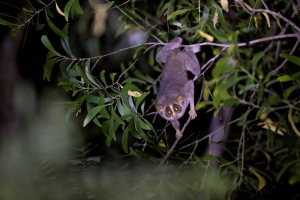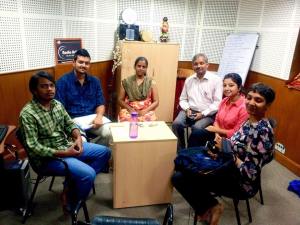Slender Loris is a small nocturnal animal. It belongs to the monkey (primates) family, but it cannot jump like a monkey. The reason that they are grouped under the monkey family is because they have forward facing eyes, a thumb and that the claws have been modified to nails. The total body length of an adult varies from 18 to 26 cm, and total body weight from 85 to 347 gm. The second digit on both hands and feet are reduced, and move somewhat in the same plane as the thumb or big toe.
It is an arboreal mammal and lives on canopies formed by trees and climbers. They need contiguous canopies at mid and high levels, starting from 5 m to up to 15 meters. Their habitat ranges from arid, semi-arid, deciduous, semi-deciduous scrub dry forests to tropical, sub-tropical, semi-evergreen wet & dry forests. Slender Loris’ known geographical distribution is South India and Sri Lanka in the whole of the world. Slender Lorises sleep in thickets of thorny plants / bushy climbers / leaves forming a basket kind of structure. Trees that the loris are usually seen using are Acacia / Ziziphus etc. It can be categorized as an omnivore with high insect consumption. Crickets, cockroaches, centipedes, are the most common diet. Adaptations vary depending on the habitat and food availability. In captivity they eat fruits – banana in specific, vegetables and eggs.
With regard to their social behavior, Slender Lorises are neither completely solitary nor completely live in groups. They are solitary foragers and sleep in groups – usually a mating pair, with young ones until weaned. The social behaviour of loris is usually that of grooming, fur-clasping, hand-grabing, play-wrestling and so on and so forth. Although there has been no predation recorded by any of the researchers, it is possible that snakes, large owls or diurnal raptors predate lorises. In Bangalore, crows are often seen threatening the lorises.
It usually breeds in the pre-monsoon months twice a year i.e. April-May & October-November and the mothers start to wean at about four months of the infant’s age and, by five or six months juveniles become independent of their mothers.
The Urban Slender Loris Project (USLP) is a Citizen Science project is lead by Dr. Kaberi Kar Gupta who is the Principal Scientist of USLP. Her Ph.D. thesis was the first study on slender lorises in the wild and, the only radio telemetry study so far. The project aims at documenting the past and present distribution of slender lorises in the landscapes of urban Bangalore to develop a better plan for managing the city’s urban green space that can accommodate wildlife coexisting with growing human population.
Bangalore or Bengaluru has had a history of its own; and as part of the many historical perspectives, there is also this small, cute animal that has always been part of the city’s identity – the slender loris or kaadupaapa. Well, it is also the state animal of Karnataka. This little nocturnal mammal has been a part of the landscape ever since the city was formed.
There is a certain amount of curiosity and amazement that is always attached to this tiny animal. While this animal is very much a part of urban wildlife today, a very little is known of the animal both scientifically and otherwise. This is the very aim of the Citizen Science project called the Urban Slender Loris Project that was started almost 8 months back – to establish the presence or absence of slender lorises in Bangalore in a scientific manner and, to bring in the awareness about its ecological importance in an urban space
– Padma Ashok
To learn about yet another urban wildlife species, tune in to Animal Instincts episode, as part of the Urban Wildlife month, on Radio Active CR 90.4 MHz on Saturday 25th July 2015 at 12 noon, to listen to the conversation that Padma Ashok is having with her team members of the Urban Slender Loris Project – Hari Prakash J R, Sayan Dutta Choudhury, Arun P Visweswaran, Vidisha Kulkarni and Harshitha C Kumar

